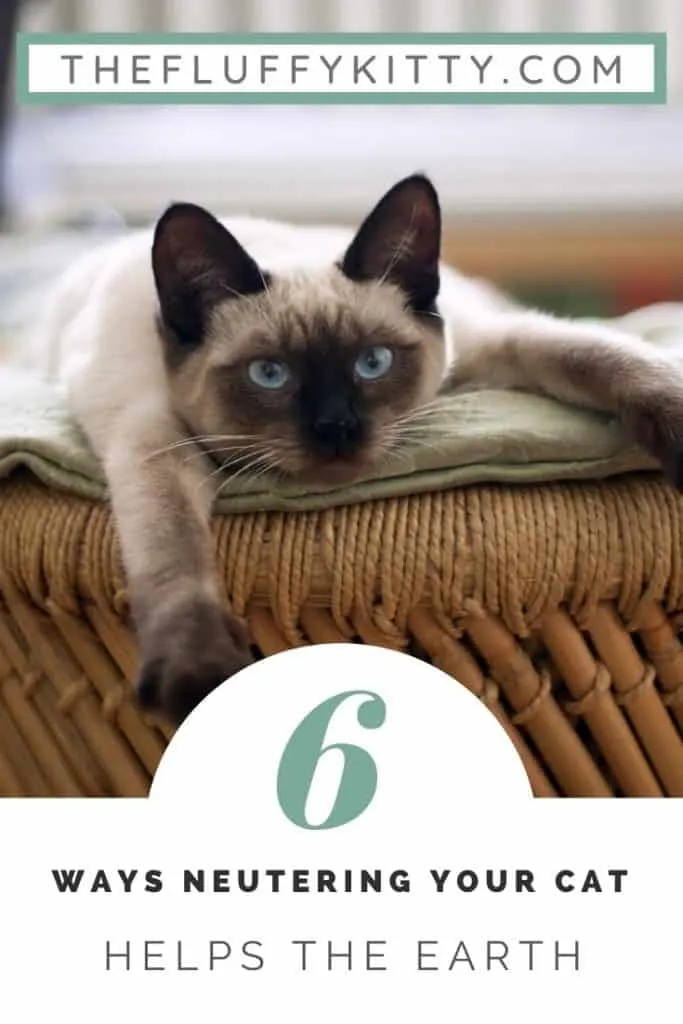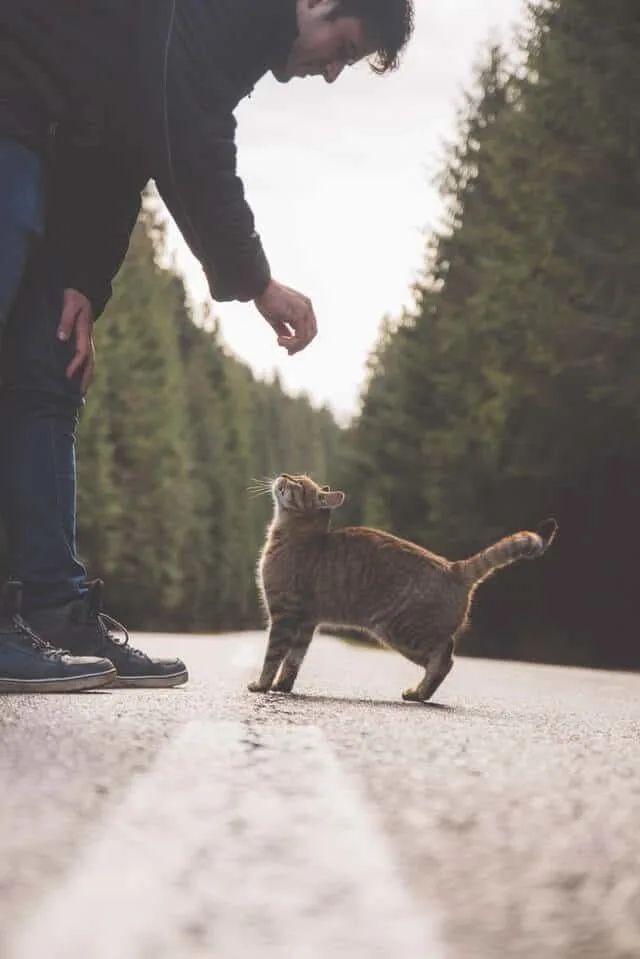Learn how spaying or neutering your cat can help the environment plus our tips on how you can help out.
Article last updated: [last-modified]
In the United States alone, there are estimates of over 85 million cats and 78 million dogs. Each year, animal shelters nation-wide take in a new 6.5 million dogs and cats (- 3.3 million cats). Of those roughly 3.3 million cats, 1.5 million are euthanized.
Can you imagine the impact on the environment?
The sad reality of euthanizations and homeless animals is not just heartbreaking. The surplus of companion animals in the U.S. alone is having a drastic and negative impact on the environment and local ecosystems.
There might be little you think you can do. But think again!
The long-term positive impact neutering has on your pet and the environment is infinite. You can help reduce pet population, unwanted pets, and euthanized cats, all while preserving diverse wildlife and rich ecosystems.

1. Neutering and spaying cats significantly help to reduce pet overpopulation
An unspayed female cat can produce up to three litters per year, with each litter averaging four kittens. Their twelve potential offspring can then multiply. Within 2-4 years, a single unspayed female cat and her offspring can produce over 10,000 kittens! Source: ASPCA
The problem of pet overpopulation is already undeniable. For years organizations have been combatting this issue. But it’s not enough. We shouldn’t have excuses for having unwanted litters of kittens each spring season.
Spaying and neutering are better for cats’ health and the environment’s health, so why wouldn’t you want to do it?
Neutering/spaying = prevents surplus in pet population = preserves wildlife and prevents euthanizations of unwanted pets.
2. Neutering reduces the # of strays which helps preserve local wildlife
Cats alone are responsible for the extinction of 63 species of wild birds, mammals, and reptiles and continue to wreak havoc on the environment.
By spaying or neutering your cat, you directly help preserve local wildlife by reducing the number of cats abandoned, put in shelters, and so on.
Take Australia for example. The country is allowing the legal hunting of cats in order to reduce the number of cats who are destroying Australia’s native species. Source: NY Times
Australia’s national government, which decided in 2015 to try to kill two million feral cats by 2020, out of grave concern for the nation’s indigenous wildlife — in particular, groups of small, threatened rodent and marsupial species for which cats have become a deadly predator.
The Royal Melbourne Institute of Technology estimated that 211,560 cats were killed during the first 12 months after the plan was announced. Dropping lethal sausages from the sky is only part of the country’s efforts to eradicate feral cats, which also include trapping, shooting and devising all manner of poison-delivery vessels.
One Green Planet suggests, “stray or feral cats and dogs are not the only cause of concern when it comes to pet overpopulation. Many pet owners don’t realize that neglecting to spay or neuter their pets directly contributes to pet overpopulation, whether through intentional breeding or the creation of ‘oops’ litters.”
Indeed, don’t put the blame on stray or feral cats for ruining the environment. If you let your female cat become pregnant, or let your male cat impregnate, you are contributing to the pet overpopulation.
In addition to neutering your pet, don’t forget to keep your cat indoors to help prevent loss of wildlife.
3. Neutering your cat reduces disease and aggression, which leads to unwanted pets and costly vet bills
Neutering is better for your cat’s health and life longevity.
Studies show cats who are neutered are less aggressive and have less chance of developing urinary tract problems or even terminal diseases such as cancer.
Such displays of behavior, or inability to care for the sick animal, leave pet owners no choice but to rehome or reshelter their animals. Doing this might seem like an innocent choice. But in fact, it’s quite harmful to both pets and the environment.
Shelters already struggle with the burden of overpopulation. Keeping your companion pet for life is the wisest, most humane, and eco-friendly choice.
In ASPCA’s National Rehoming Survey, pet problems are the most common reason that owners rehome their pet, accounting for 47% of rehomed dogs and 42% of rehomed cats. Pet problems were defined as problematic behaviors, aggressive behaviors, grew larger than expected, or health problems owner couldn’t handle.
The small cost of neutering while your pet is young has overwhelming pros. And not to mention, it will actually save you tons of money in the long-term.

4. Neutering and spaying cats reduce the number of shelter euthanizations
As we mentioned earlier, there are roughly 1.5 million cats euthanized each year. That number is heavy – both on our hearts and on the environment. There is simply too much waste of innocent life.
Neutering and spaying help prevent unwanted kittens from ending up in shelters. It also gives the older cats already in shelters waiting for a home, a chance to get adopted.
Kittens are much likelier to be adopted than mature cats. So when kittens are submitted to shelters, the cats who have been waiting for months are put aside.
If no one saves them, the shelter cannot provide for that cat for months on end. As a result, millions of healthy, innocent cat lives are taken because people aren’t getting their own cats spayed or neutered to help prevent unwanted kitten litters who end up in shelters.
There’s something else you can do while you’re here – do not breed your cats. Breeding for the sole purpose of breeding to earn a profit is cruel. And always, always adopt. #AdoptDontShop
5. Neutering cats reduces feral cat colonies
Feral cats, cats who are not socialized to humans and are shy or fearful, live outdoors across the U.S. in alarming numbers. The Humane Society estimates roughly 30 to 40 million.
Community cat colonies form when a group of stray or feral cats lives together. Some colonies receive human help with food, water, and shelter, while others are completely wild and independent; forced to scavenge, hunt and kill for food.
Cat colonies can have harmful impacts on the local environment. It comes to no surprise that such large groups of cats can disrupt, or even destroy, an entire native species of birds or mammals, as we saw above.
Neutering, through TNR programs, at least helps reduce the number of cats to care for.
The more feral or stray cat colonies to provide for, the more it costs in food, care, and shelter, which produces even more waste.
6. Spaying and neutering keeps your cat AND the environment healthier
When you choose to spay or neuter a cat, possibly your own, you are not only prolonging your cat’s health, but you are also helping the environment.
As we see, neutering isn’t a single act with limited impact. The simple act of neutering a cat has a multitude of benefits that all interrelate.
When you neuter your cat, you prevent unwanted cat pregnancies. Doing so prevents unwanted litters, and a surplus in kittens and cats left abandoned to form feral colonies that obliterate small species and create even more cats via rapid reproduction. And because you neutered, fewer cats end up in shelters which are burdened with euthanizing unwanted cats who don’t find homes. And so on and so forth…
There’s really no point not to spay or neuter a cat, beyond breeding. And as we discussed, breeding is not a sustainable or humane option.
6 Easy Ways to Help Out in Your Community
We all have a role to play in reducing the amount of waste and suffering in the world.
Here’s what you can do in your own community to help the pet population.
- Spay or neuter all your cats and dogs (as early as possible)
- Tell your family and friends about the importance of neutering/spaying
- Adopt from your local animal shelter, giving preference to older cats or cats who’ve been waiting for a home the longest
- Do not buy from breeders
- Donate to your local animal shelters or volunteer your time
- Feed stray cats in your neighborhood and report any strays or ferals to be TNR
If we make the effort, we can greatly reduce the loss of life due to pet overpopulation!

Final Thoughts: 6 Ways Neutering Your Cat Helps the Environment
Never underestimate what good spaying or neutering can do for your pet and for the environment.
If you want to truly be an eco-friendly pet owner, the first step is taking the responsibility to prevent unnecessary surplus in the pet population by choosing to spay and neuter your pets.
Neutering and spaying is the key to helping the environment while saving our pet’s lives. 🙂
If you have questions or comments, please drop us a comment below! If you are a shelter, pet organization or business looking for support, please see our Pawtner with Us page.
